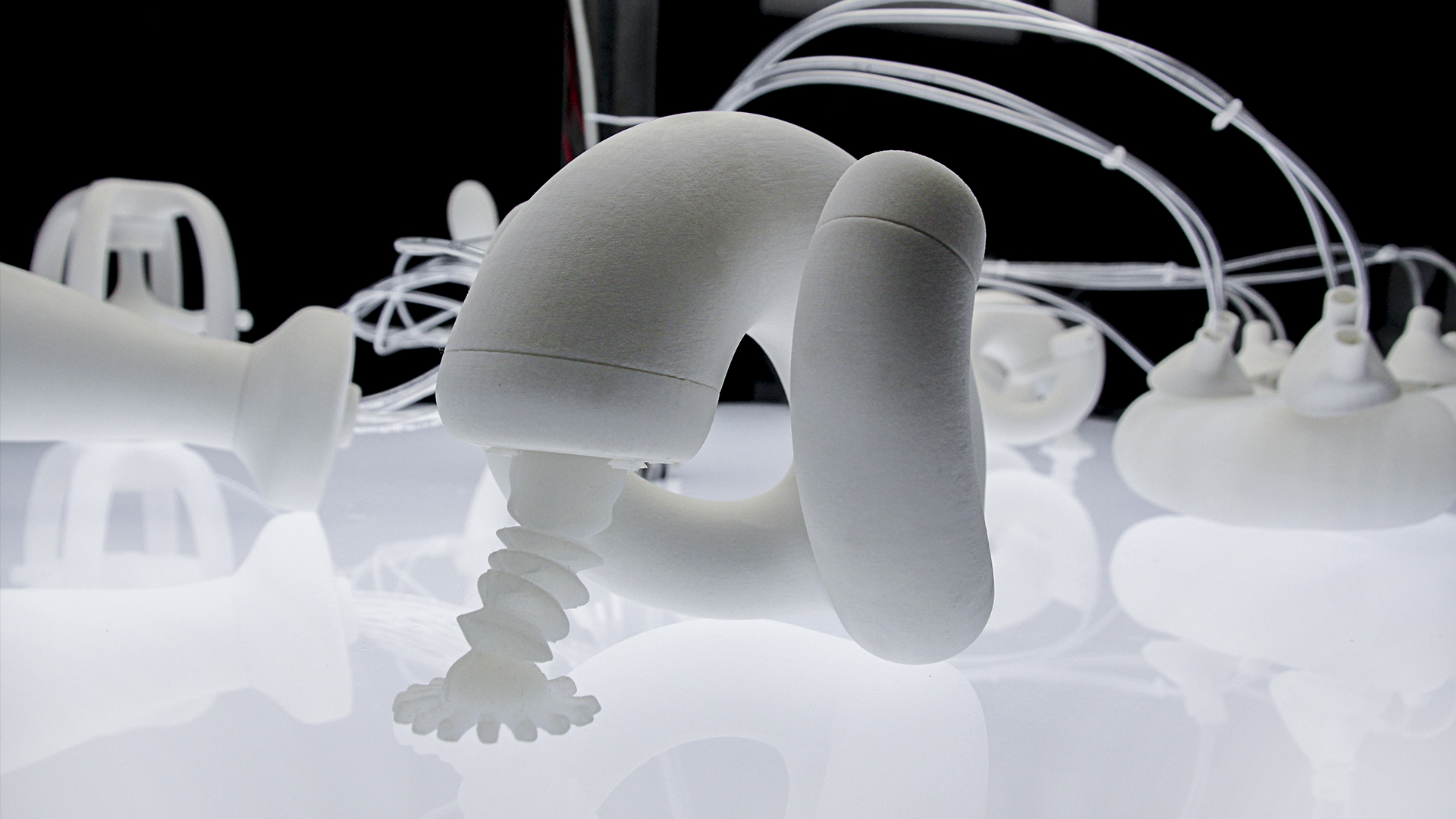Exo-biote,
2014-2015.
Installation
penumatique et lumineuse
Impressions
3d plâtre, moulage silicone, tuyaux pvc, cathéter, verre, métal,
bois, plexiglas, LED, compresseur, distributeurs, arduino mega,
circuit imprimé, 2mx1.5mx1.5m.
FR
Le projet Exo-biote vise à inventer une typologie de
formes et de mouvements possibles en détournant des technologies
développées en « soft-robotique ».
L'installation met en scène des objets-sculptures en mouvement. Ces
objets hybrides se gonflent d'air,
ils semblent vivants, suivant leur propre souffle. Ces composants
participent d'un tout, ils appartiennent à un même corps dont on peut
observer les humeurs par les battements de ses organes. Une chorégraphie
spasmodique entraîne le spectateur dans un voyage intérieur, le conduit
dans les méandres d’un de ces raisonnements par l’absurde que les
logiciens nomment « apagogies », en proposant d’hypothétiques prothèses
de grande consommation ... Comme si les objets présentés étaient des
marchandises, des objets prêts à l'emploi, des organes de substitution
produits en série.
Travailler avec des technologies souples, molles, vient d'abord d'une
observation : au fil des progrès technologiques, l'ordinateur et le
corps humain entrent dans un rapport de proximité de plus en plus
intime. Dans une logique prospective, cette proximité croissante entre
l'homme et la machine m’a conduit à imaginer une modification
structurelle des ordinateurs, à la manière des « pods » d’Existenz (D. Cronenberg, 1999). Je fais l'hypothèse que l'ordinateur, la
machine, a un « devenir
organique », un devenir vivant, souple. Cette manière de concevoir la
robotique et l’électronique prend-elle racine dans notre temps ?
EN
The Exo-biote project aims to invent a typology of possible forms and movements by diverting “soft robotics” technologies. The installation features moving sculpture-objects. These hybrid objects swell with air and seem to be alive, to breathe. These components are part of a whole, they belong to the same body, one whose humours and pulsing organs we can observe.
The installation features moving objects-sculptures. These hybrid objects inflate with air, they seem alive, following their own breath. These components are part of a whole, they belong to the same body whose moods can be observed by the beats of its organs. A spasmodic choreography takes the spectator on an inner journey, leading him into the twists and turns of one of those reasonings by the absurd that logicians call «apagogies», by proposing hypothetical conmmercial prostheses... As if the objects presented were commodities, ready-made objects, mass-produced substitute organs.
Working with flexible, soft technologies comes first from an observation: over the course of technological progress, the computer and the human body enter into an increasingly intimate relationship. In a prospective logic, this growing proximity between man and machine led me to imagine a structural modification of computers, like the “pods” of Existenz (D. Cronenberg, 1999). I postulate that the computer, the machine, has an «organic becoming». Does this way of conceiving robotics and electronics takes root in our time?



Interview à propos d’Exo-biote sur .able
https://able-journal.org/wp-content/uploads/2023/11/The_first_breath-fr-hq.pdf
-------------
